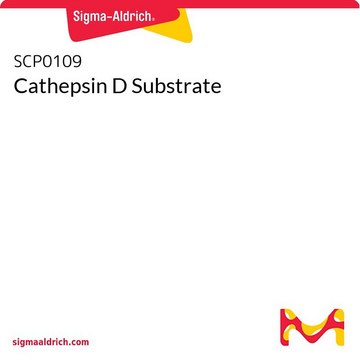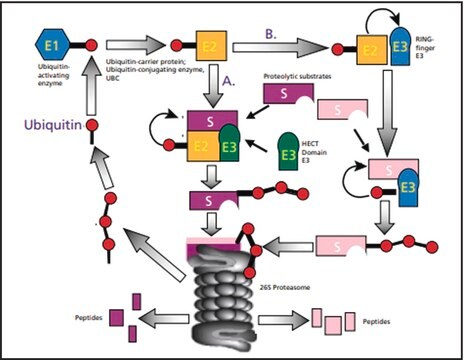SRP6415
Cathepsin D human
recombinant, expressed in HEK 293 cells, ≥95% (SDS-PAGE)
Synonim(y):
CLN10, CPSD, CTSD
About This Item
Polecane produkty
pochodzenie biologiczne
human
rekombinowane
expressed in HEK 293 cells
znacznik
6-His tagged (C-terminus)
Próba
≥95% (SDS-PAGE)
Formularz
lyophilized
masa cząsteczkowa
calculated mol wt 43.6 kDa
observed mol wt 45-55 kDa (DTT-reduced. Protein migrates due to glycosylation. Ser 19 is the predicted N-terminal.)
opakowanie
pkg of 10 μg
producent / nazwa handlowa
Sigma-Aldrich
warunki przechowywania
dry at room temperature
metody
activity assay: suitable
zanieczyszczenia
<1 EU/μg endotoxin (LAL test)
przydatność
suitable for molecular biology
numer dostępu UniProt
Zastosowanie
life science and biopharma
Warunki transportu
wet ice
temp. przechowywania
−20°C
informacje o genach
human ... CTSD(1509)
Opis ogólny
Zastosowanie
Działania biochem./fizjol.
Postać fizyczna
Rekonstytucja
Kod klasy składowania
11 - Combustible Solids
Klasa zagrożenia wodnego (WGK)
WGK 3
Temperatura zapłonu (°F)
Not applicable
Temperatura zapłonu (°C)
Not applicable
Wybierz jedną z najnowszych wersji:
Certyfikaty analizy (CoA)
It looks like we've run into a problem, but you can still download Certificates of Analysis from our Dokumenty section.
Proszę o kontakt, jeśli potrzebna jest pomoc Obsługa Klienta
Masz już ten produkt?
Dokumenty związane z niedawno zakupionymi produktami zostały zamieszczone w Bibliotece dokumentów.
Nasz zespół naukowców ma doświadczenie we wszystkich obszarach badań, w tym w naukach przyrodniczych, materiałoznawstwie, syntezie chemicznej, chromatografii, analityce i wielu innych dziedzinach.
Skontaktuj się z zespołem ds. pomocy technicznej








